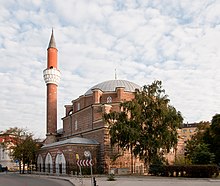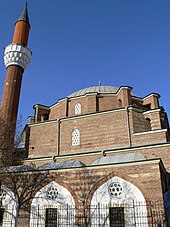Banya Bashi Mosque
The Banja Baschi Mosque ( Bulgarian Баня Баши джамия / Banja baschi dschamija, Turkish Banyabaşı Camii ) is the largest and only active mosque in the Bulgarian capital Sofia . It is one of the most important buildings in Sofia from the time of Ottoman rule and was built in 1566/67. It is one of the oldest mosques in Europe.
location
The Banya Bashi Mosque is located on Knjaginja Maria Luisa Boulevard in the center of Sofia. Immediately to the east of the mosque is the Sofia Central Mineral Bath (built in 1913) with the "Bad-Platz" (площад "Бански" / Ploschtad "Banski") and to the west of it, on the other side of the boulevard Knjaginja Maria Luisa , is the Sofia Central Market Hall ( 1911).
history
The Banja Baschi Mosque is named after the former bath house, not to be confused with today's Central Mineral Bath Sofia, built in 1913. At this point in the center of Sofia, where a thermal spring with a temperature of 46 ° C has risen since Roman times , a public Turkish bath ( hammam or oriental bath ), which was directly adjacent to the mosque , had stood since at least the 16th century . Before the new large central mineral bath was built in 1913, this old Turkish bath had already fallen into disrepair. The Banja Baschi Mosque was named after this old, much smaller Turkish bath, which was even closer to the mosque than today's central bath.
Banja means bath. Banja-Baschi means many baths , which is why the name of the mosque is also translated as bath mosque . The founder of the Banja Bashi Mosque was Mullah (Molla) Efendi Kadı Seyfullah, who had the mosque built in memory of his deceased wife. Older sources therefore refer to this mosque as Molla Efendi Mosque or Kadı Seyfullah Mosque .
When Evliya Çelebi visited Sofia in the 17th century, the city had 53 mosques. According to other sources, it later had over 100 mosques. In an earthquake in 1858 with a magnitude of 6.5 on the Richter scale , 19 of the 24 minarets that existed at that time in Sofia overturned, otherwise there were no human lives to be mourned in this earthquake. At the end of the Ottoman rule, Sofia had 50 to 84 mosques. After the end of Ottoman rule (1878) there were still 32 mosques in Sofia. Five of these buildings are still preserved today. The Banya Bashi Mosque is the only mosque in use in the Bulgarian capital that has been preserved in its original form. In the building of the former Great Mosque (Bulgarian Буюк джамия / Bujuk dschamija; Turkish. Büyük Camii) is now the National Archaeological Museum .
A text is painted on the arch above the entrance door, but it can no longer be deciphered. Below is the year 974, which is why it is assumed that the mosque was built in the year 974 according to the Islamic calendar , which began with the hijra . According to the Christian calendar ( Gregorian calendar ), this corresponds to the year 1566 or 1567. According to the Julian calendar, the Islamic year 974 lasted from July 19, 1566 to July 9, 1567. At that time, the Ottoman Empire ruled Sofia and most of the Balkan Peninsula . Around 1440 Sofia had become the center of a Rumelian Bejlerbej , which administered all Bulgarian territories and comprised 25 districts.
A previous building of today's mosque was built in 1474, during the time of the provincial governor ( Beylerbey ) Mehmed Pasha, who later became Sultan Mehmed II.
During the communist rule in Bulgaria (1944-1989) the mosque was not in use. Since 1989 the calls to prayer of the muezzins can be heard again from the minaret.
The mosque today
Although the mosque is not officially open to tourists, they will be admitted outside of the five prayer times . Women are also allowed in in appropriate clothing, but must wear a headscarf, which is available at the entrance. At prayer times, the muezzin's call to prayer can be heard from speakers in the minaret, which are so quiet that they are almost drowned in the noise of the street. The first (5 a.m.) and the last call to prayer (10:30 p.m.) are omitted for reasons of noise protection. The call to prayer lasts a minute and a half and is in Arabic. In this way, both the wishes of Muslims and non-Muslims with regard to noise pollution are taken into account. In 2006 there was a citizens' initiative with collections of signatures from non-Muslims against the noise caused by the calls to prayer. However, no judicial or administrative bans or regulations followed.
The sermon in the mosque is in Bulgarian and Turkish. Only the compulsory prayers are read out in the prescribed Arabic original language. Often, Muslims are also standing in front of the mosque during prayer times, as there is not enough space in the mosque for all visitors , especially during the Islamic fasting month of Ramadan and on public holidays.
architecture
The main building of the mosque has a square base and has a large central lead dome with a diameter of 15 meters. The building does not stand parallel to Knjaginja Maria Luisa boulevard , but rather faces the street with its western corner, on which the tall, slender minaret also stands. The main entrance is located on the northwest side, which is covered by a porch (Tetimme = outbuilding) with three smaller domes.
The mosque is built in the typical Ottoman architectural style of the 16th century. The builder was Mimar Sinan , one of the greatest architects of the Ottoman Empire. He also built the Selimiye Mosque in Edirne . The walls are built from alternating layers of hewn stone and red brick. On the four corners of the roof, small turrets with openings serve as supporting walls. A warm mineral spring (46 ° C) rises at the point where the mosque stands. The rising steam can be seen near the walls of the mosque.
The walls of the prayer room and the arches are made of carved stone. The pillars are each carved from a single stone. The arch over the front door is also carved from stone. The main dome is covered with lead sheets. The interior of the mosque only got its current appearance after several renovations. The last major renovation was carried out in the 1920s with financial support from the Turkish ambassador to Bulgaria, Fethi Okyar . After the Second World War a partial renovation (plastering, painting, etc.) was carried out. Renovations in the last few decades were made possible by the support of Turkish and Arab Waqf (foundation). With their support, underfloor heating was installed.
The mosque has two floors, the upper floor is, as is usual in mosques, reserved for women. The imam stands on a pulpit ( minbar ) during his sermon . The walls of the Banja Bashi Mosque are white and blue. Since the Islamic ban on images applies, the walls are decorated with Arabic calligraphy , quotations from the Koran. The tomb of Mullah Efendi Kadı Seyfullah used to be next to the mosque.
Changes inside or outside have not been permitted since the mosque was declared a cultural monument.
In its current state, the mosque offers space for 700 believers at Friday prayers and for almost 1200 on religious holidays ( Bayram ). The Muslim community in Sofia numbers around 30,000 Muslims .
See also
Web links
- 3D panorama pictures from inside, outside and view from the minaret
- Pictures of historical postcards from the Banya Bashi Mosque
Coordinates: 42 ° 41 ′ 58.4 " N , 23 ° 19 ′ 21.3" E





